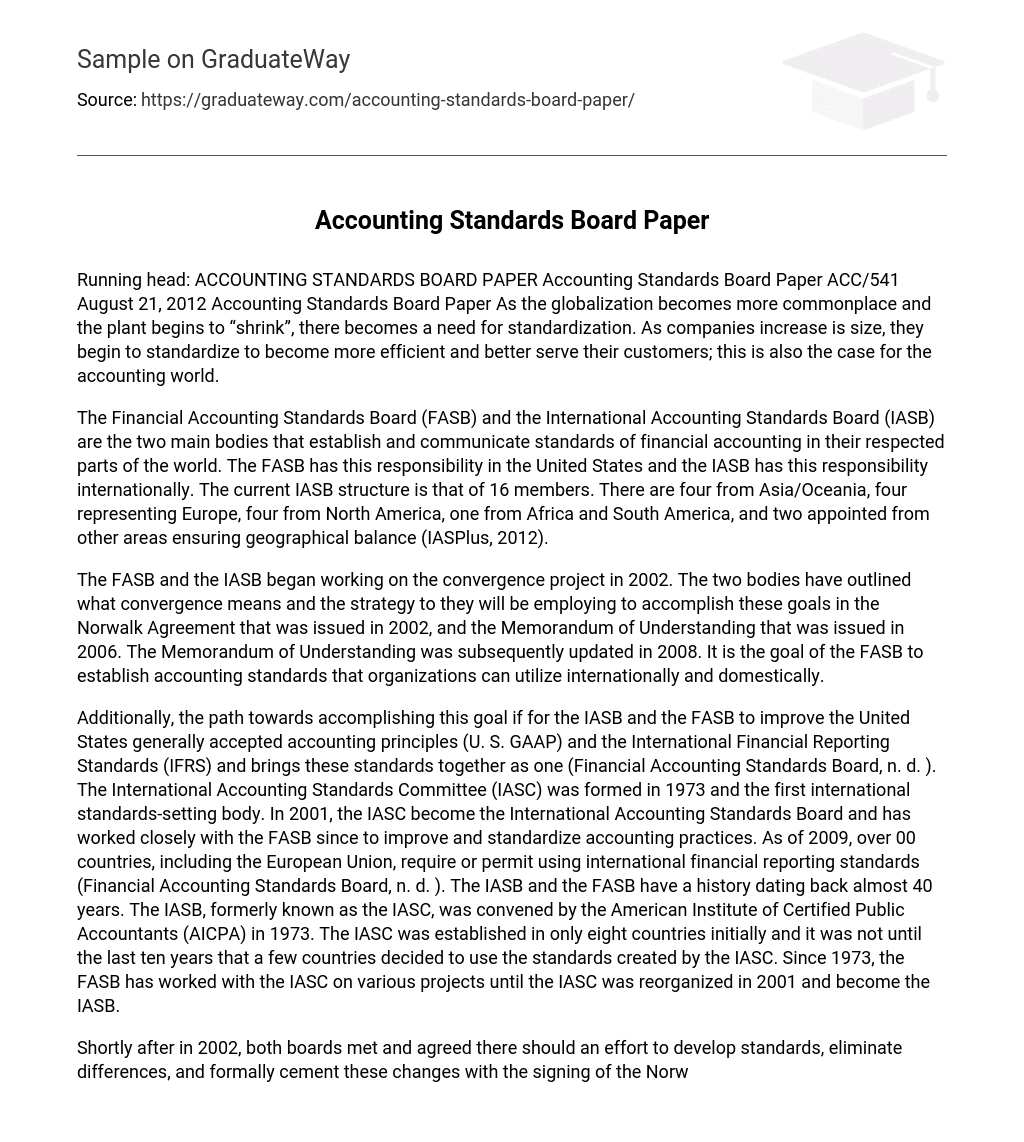As the globalization becomes more commonplace, and the plant begins to “shrink”, there becomes a need for standardization. As companies increase is the size, they begin to standardize to become more efficient and better serve their customers; this is also the case for the accounting world.
The Financial Accounting Standards Board (FASB) and the International Accounting Standards Board (IASB) are the two main bodies that establish and communicate standards of financial accounting in their respected parts of the world. The FASB has this responsibility in the United States and the IASB has this responsibility internationally. The current IASB structure is that of 16 members. There are four from Asia/Oceania, four representing Europe, four from North America, one from Africa and South America, and two appointed from other areas ensuring geographical balance (IASPlus, 2012).
The FASB and the IASB began working on the convergence project in 2002. The two bodies have outlined what convergence means and the strategy until they will be employing to accomplish these goals in the Norwalk Agreement that was issued in 2002, and the Memorandum of Understanding that was issued in 2006. The Memorandum of Understanding was subsequently updated in 2008. It is the goal of the FASB to establish accounting standards that organizations can utilize internationally and domestically.
Additionally, the path towards accomplishing this goal if for the IASB and the FASB to improve the United States generally accepted accounting principles (U. S. GAAP) and the International Financial Reporting Standards (IFRS) and brings these standards together as one (Financial Accounting Standards Board, n. d. ). The International Accounting Standards Committee (IASC) was formed in 1973 and the first international standards-setting body. In 2001, the IASC becomes the International Accounting Standards Board and has worked closely with the FASB since, to improve and standardize accounting practices. As of 2009, over 00 countries, including the European Union, require or permit use international financial reporting standards (Financial Accounting Standards Board, n. d. ).
The IASB and the FASB have a history dating back almost 40 years. The IASB, formerly known as the IASC, was convened by the American Institute of Certified Public Accountants (AICPA) in 1973. The IASC was established in only eight countries initially and it was not until the last ten years that a few countries decided to use the standards created by the IASC. Since 1973, the FASB has worked with the IASC on various projects until the IASC was reorganized in 2001 and become the IASB.
Shortly after in 2002, both boards met and agreed there should an effort to develop standards, eliminate differences, and formally cement these changes with the signing of the Norwalk Agreement (Financial Accounting Standards Board, n. d. ). The FASB was motivated to improve on some of the weaknesses of the APB. In doing so, the FASB undertook the Conceptual Framework Project (CFP). For this project, the FASB issued Statements of Financial Accounting Concepts. According to Schroeder, Clark, & Cathey (2011), the concepts are as follows: No. 1: “Objectives of Financial Reporting by Business Enterprises”; No. : “Qualitative Characteristics of Accounting Information”; No. 3: “Elements of Financial Statements of Business Enterprises”; No. 4: “Objectives of Financial Reporting by Nonbusiness Organizations; No. 5: “Recognition and Measurement in Financial Statements of Business Enterprises”; No. 6: “Elements of Financial Statements” (SFAC No. 6 replaced SFAC No. 3); and No. 7: “Using Cash Flow Information and Present Value in Accounting Measurements. ” Similarly, the IASC developed a conceptual framework that was created for the external users by outlining the preparation and presentation of financial statements.
The framework specifics are as follows:
- Objective of financial statements
- Determine what qualitative characteristics are useful in financial statements
- Define, recognize, and measure the elements that are the foundation of the financial statements
- The concepts of capital and capital maintenance
The MSA program assists students in preparing for professional life by providing the students with an education that are time-appropriate for today’s business world.
The content discussed in the reading is generally no more than a few years old and is relevant to events occurring in the business world. Additionally, the professors at the University of Phoenix are currently employed in the professions in which they are teaching and can provide real-world examples and apply them to the theory. In fact, the real-world examples are often more helpful than the theory that is taught in books. For the most part, normative theory is discussed in the literature.
In the work place, variables such as culture, politics, individual needs, and the like may be a factor in determining who theory is actually applied. In closing, this purpose of this paper was to discuss the relationship between the International Accounting Standards Board and the Financial Accounting Standards Board along with the original FASB pronouncements and their IASB equivalents. Additionally, insight was provided on how the MSA program prepares student for the real-world.





